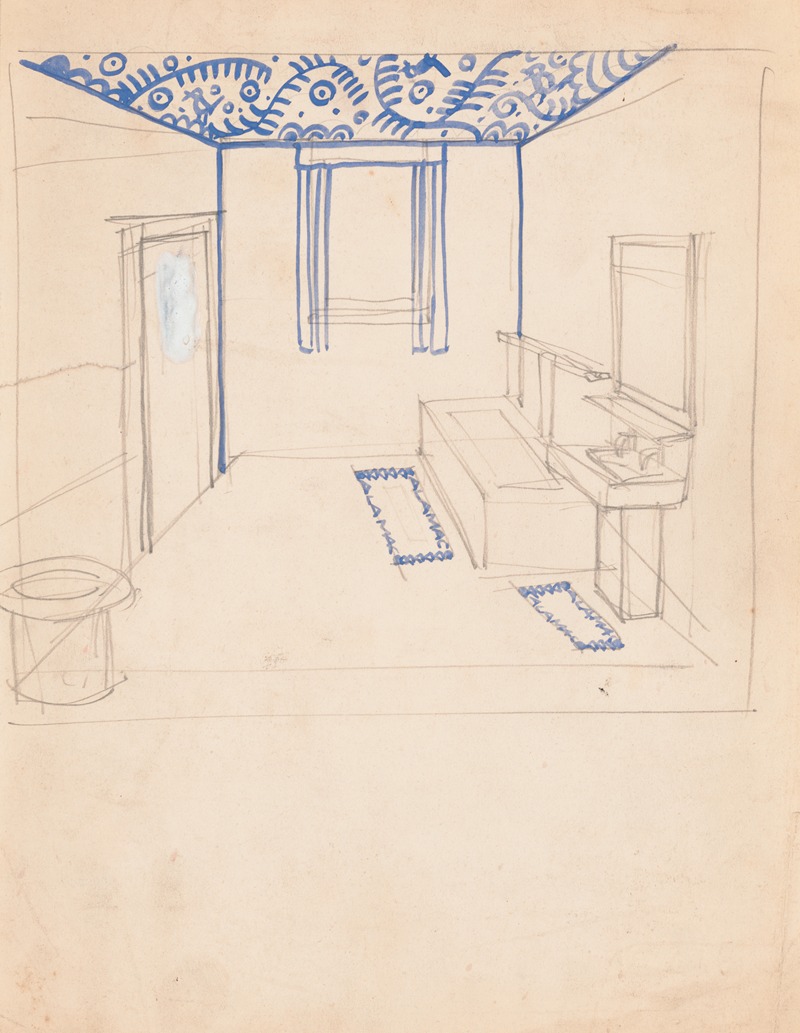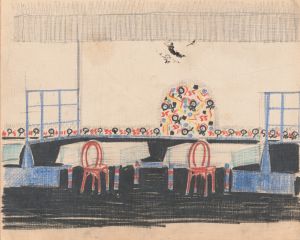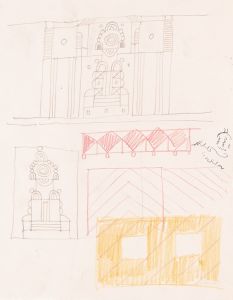
Interior design sketches for Alamac Hotel, 71st and Broadway, New York, NY.] [Incomplete interior perspective of a bathroom
A hand-painted replica of Winold Reiss’s masterpiece Interior design sketches for Alamac Hotel, 71st and Broadway, New York, NY.] [Incomplete interior perspective of a bathroom, meticulously crafted by professional artists to capture the true essence of the original. Each piece is created with museum-quality canvas and rare mineral pigments, carefully painted by experienced artists with delicate brushstrokes and rich, layered colors to perfectly recreate the texture of the original artwork. Unlike machine-printed reproductions, this hand-painted version brings the painting to life, infused with the artist’s emotions and skill in every stroke. Whether for personal collection or home decoration, it instantly elevates the artistic atmosphere of any space.
Winold Reiss was a German-American artist known for his work in interior design, illustration, and portraiture. Born in 1886 in Karlsruhe, Germany, Reiss immigrated to the United States in 1913, where he became a prominent figure in the American art scene. His work often combined elements of European modernism with American themes, and he was particularly noted for his vibrant use of color and innovative design techniques.
One of Reiss's notable projects was his involvement in the interior design of the Alamac Hotel, located at 71st and Broadway in New York City. The Alamac Hotel, which opened in the early 20th century, was a significant establishment during its time, catering to both long-term residents and transient guests. Reiss's contribution to the hotel included a series of interior design sketches, which showcased his unique artistic vision and attention to detail.
Among these sketches is an incomplete interior perspective of a bathroom. This particular piece reflects Reiss's ability to blend functionality with aesthetic appeal, a hallmark of his design philosophy. The sketch likely features elements typical of Reiss's style, such as bold colors, geometric patterns, and an emphasis on harmony between different design components. Although the sketch is incomplete, it provides insight into Reiss's creative process and his approach to interior spaces.
Reiss's work on the Alamac Hotel is part of his broader legacy in the field of interior design. He was known for his ability to create spaces that were not only visually striking but also culturally resonant. His designs often incorporated motifs and influences from various cultures, reflecting his belief in the power of art to transcend cultural boundaries.
In addition to his work in interior design, Reiss was also a prolific portrait artist. He is perhaps best known for his portraits of Native Americans and African Americans, which he created with a sense of dignity and respect that was rare for his time. His portraits were characterized by their vivid colors and dynamic compositions, capturing the essence of his subjects with both sensitivity and strength.
Reiss's contributions to the arts extended beyond his own creations. He was also a teacher and mentor to many young artists, sharing his knowledge and passion for art with the next generation. His influence can be seen in the work of numerous artists who followed in his footsteps, and his legacy continues to be celebrated in both the United States and Germany.
Overall, Winold Reiss's work on the Alamac Hotel and his broader contributions to the fields of art and design highlight his importance as a cultural figure in the early 20th century. His innovative approach to design and his commitment to cultural inclusivity remain influential, making him a significant figure in the history of American art and design.





![Graphic designs for Fortune Magazine.] [Study for cover with telephone lines at different locations on the globe](/imgs/249255/s/winold-reiss-graphic-designs-for-fortune-magazine-study-for-cover-with-telephone-lines-at-different-locations-on-the-globe-d53cdea6.jpg)
![Design drawings for miscellaneous interiors, some possibly related to the Hotel St. George, New York, NY.] [Sketch for miscellaneous interior .](/imgs/249277/s/winold-reiss-design-drawings-for-miscellaneous-interiors-some-possibly-related-to-the-hotel-st-george-new-york-ny-sketch-for-miscellaneous-interior--6b46aedb.jpg)
![Design for the Lentheric Salon, Fifth Ave. & 58th St., Savoy-Plaza Hotel, New York, NY.] [Perspective sketch](/imgs/249294/s/winold-reiss-design-for-the-lentheric-salon-fifth-ave-58th-st-savoyplaza-hotel-new-york-ny-perspective-sketch-d1e86315.jpg)
![Design for unidentified restaurant, possibly Dunhall’s Restaurant, New York, NY.] [Mural of masks and dancing figures](/imgs/249302/s/winold-reiss-design-for-unidentified-restaurant-possibly-dunhalls-restaurant-new-york-ny-mural-of-masks-and-dancing-figures-2b52066c.jpg)
![Interior perspective drawings of Hotel Siwanoy, Mount Vernon, NY.] [Interior perspective of dining room](/imgs/249368/s/winold-reiss-interior-perspective-drawings-of-hotel-siwanoy-mount-vernon-ny-interior-perspective-of-dining-room-d26480cd.jpg)

![Interior perspective studies for Restaurant Crillon, 15 East 48th Street, New York, NY.] [Study for Batik Room or Main Dining Room](/imgs/249377/s/winold-reiss-interior-perspective-studies-for-restaurant-crillon-15-east-48th-street-new-york-ny-study-for-batik-room-or-main-dining-room-f49c2d45.jpg)
![Interior perspective studies for Restaurant Crillon, 15 East 48th Street, New York, NY.] [Study for Le Passage or Pullman Room](/imgs/249378/s/winold-reiss-interior-perspective-studies-for-restaurant-crillon-15-east-48th-street-new-york-ny-study-for-le-passage-or-pullman-room-b703bb8b.jpg)

![Design proposals for Puck Theater, New York, NY.] [Interior perspective study](/imgs/249412/s/winold-reiss-design-proposals-for-puck-theater-new-york-ny-interior-perspective-study-27d2bb72.jpg)
![Design proposals for Puck Theater, New York, NY.] [Interior perspective study.](/imgs/249413/s/winold-reiss-design-proposals-for-puck-theater-new-york-ny-interior-perspective-study-f0303b2a.jpg)
![Miscellaneous small sketches for inlaid table tops.] [Design with orange and yellow geometric motif](/imgs/249438/s/winold-reiss-miscellaneous-small-sketches-for-inlaid-table-tops-design-with-orange-and-yellow-geometric-motif-9009d68a.jpg)
